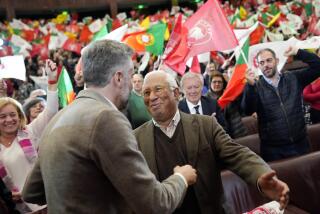There’s No Payday for the Poor in Newly Rich Angola
- Share via
LUANDA, Angola — In the shadow of an oil refinery that belches steam on a hill high above the harbor, pairs of ragged fishermen maneuver rickety boats around 30 freighters riding at anchor.
They work at a trade handed down over generations, plying the same waters, sometimes in the same leaky boats, as their fathers and grandfathers. While they toil for meager catches, modern trawlers from China and Europe are offshore, further depleting Angola’s already overfished waters.
Three years after the end of a long civil war, Angola is a rich country full of poor people. Foreign businessmen and a handful of wealthy Angolans, mostly government officials, are reaping huge profits from a postwar boom fueled by oil and diamonds.
Peace has brought a measure of prosperity even if it is distributed unevenly.
Most of the hundreds of thousands of Angolans displaced by the 27-year civil war have returned to their homes. Schools have reopened, even if they are poorly attended. The government is carrying out a slow, seemingly haphazard reconstruction campaign and is working to restart agriculture.
President Jose Eduardo dos Santos, who became president in 1979, says he is committed to holding the first national elections since 1992 this year.
“Angola has changed dramatically and in the right direction,” said Richard Corsino, the country director for the U.N. World Food Program. But, he added, it has a long, long way to go.
European companies are putting up hotels, hospitals and office buildings amid the graceful arches and faded pastels of this seaside capital’s aging colonial buildings. Luanda, the commercial heart of Angola barely touched by the war, gets priority on government spending.
“Rural areas are in shambles and I can’t say if it is by design or neglect,” said Corsino, who noted some rural areas are controlled by UNITA, the former rebel group that is now an opposition party. “There is no work in Luanda. But in the countryside the people see no hope, so they come here.”
Most of Luanda’s 5 million people live in shacks jammed together in fetid, treeless slums that stretch for miles. Most remain unemployed in a city that oil has made one of the most expensive in Africa.
“Luanda is experiencing the fastest urbanization in the world,” said Lance Bailey, an Atlanta architect and urban planner. “It is home to 44% of Angola’s population and growing at a rate of 4% a year.”
He said the city was designed for 250,000. Most of each year’s 200,000 new residents live in the slums with either inadequate or no basic services, such as water, sanitation and electricity.
Yet postwar Angola is booming: The country is the second-largest oil producer in sub-Saharan Africa, and the International Energy Agency predicts it could be No. 1 by 2008, when daily production is expected to rise from 1.2 million barrels to 2 million.
Angola also mines 6 million carats of diamonds a year. The state-owned diamond company, Endiama, says it will double production next year, overtaking South Africa as the third-biggest producer of the gems.
The mineral-rich country also has substantial reserves of gold, iron ore, copper and manganese.
*
The civil war began as a Cold War struggle between a Marxist government and U.S.-backed rebels, but by its end the fighting was over who would control Angola’s oil and diamonds.
In peace or war, huge revenue from oil and diamonds have brought staggering corruption.
The government has promised to fight the corruption that is a way of life, from huge payoffs to top officials to gasosas -- small bribes paid to underpin any transaction. But government critics remain skeptical. European businessmen note some progress, even if it is only that they are being asked for smaller bribes.
Justino Pinto de Andrade, dean of the economics faculty at Catholic University in Luanda, said the political and judicial systems were too weak to make any anti-corruption drive successful.
“Corruption is out of control because it is practiced by the highest ranks in the country,” he said.
The economist also contended that Angola’s new postwar prosperity was fragile. Most people do not benefit, he said, because most goods are imported and the government seems ambivalent about containing inflation.
The International Monetary Fund, in its recent economic assessment, said the economy grew by 14% in 2005, the largest expansion in Africa. It predicted the economy could grow by 25% this year.
*
Yet life is hard and short. Luanda’s harbor is fished by men so poor they use tree limbs for masts and plastic for sails. Seventy percent of Angolans live on less than a dollar a day.
At one cemetery near the capital’s grimy edge, row after row of graves -- mostly unmarked mounds of red clay -- nearly fill a vast site opened just five years ago. The average life expectancy is 38 years. Angola has the world’s highest infant mortality rate: 191 deaths for every 1,000 babies.
Many rural roads and bridges remain wrecked from the war, and many areas are still littered with land mines.
Efforts to restart agriculture are floundering. Most farmers, even in the fertile and once productive central highlands, live on subsistence farming and U.N. food aid.
“There is no incentive,” said Corsino, the U.N. food official. “Even if the farmers grow a surplus there is no way to get it to a market.”
More to Read
Sign up for Essential California
The most important California stories and recommendations in your inbox every morning.
You may occasionally receive promotional content from the Los Angeles Times.













